Forest Creek Golf Club (South Course)
North Carolina, United States of America
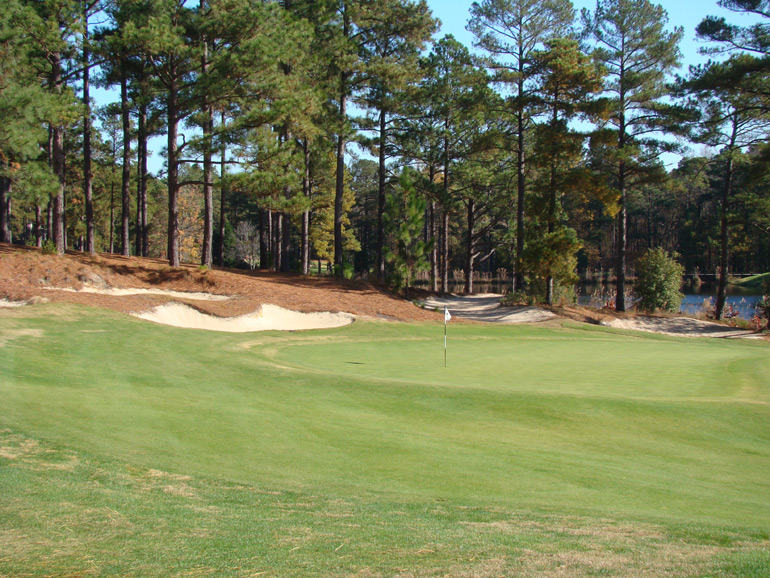
The charms of playing beneath the swaying, fragranted pines in the Sand Hills of North Carolina are on full display at the South Course at Forest Creek.
For many Pinehurst conjures up idyllic thoughts and that certainly applies to Terry Brown and his family. Starting in 1948 at the age of one, Terry and his brother Louis traveled from Chicago to visit their grandparents in Pinehurst. His grandfather Charles Louis Meyer had purchased a Manor House in 1942 on 500 acres three miles from the village of Pinehurst. A guesthouse, small log cabin, and an eight stall barn were the only other structures on the rolling, forested property. Horse riding, fox hunting and golf served as primary pastimes. Many a day began with granddad heading to the stables and grandmother off to the golf course. Back then, quail hunting was a pastime in central North Carolina. Over time and by regularly purchasing land that, Meyer impressively amassed a near 3,000 acre estate which he passed on debt-free to his wife who in turn passed it to Terry, his brother Louis and their cousin Heidi Hall-Jones in 1990.
Like their father, an alternate for the Walker Cup team just prior to World War II, Terry and Louis were both ace players and they saw a need in Pinehurst for a high-end private club that would attract the better player. Hall-Jones was also keen to see the land put to good use and the three considered several architects including Pete Dye, Jack Nicklaus and Rees Jones but it was Tom Fazio who made the best impression. Rather than talk at them, Fazio listened to the Browns and Hall-Jones and embraced their vision for the family land. While a poor economy and unrest in the Middle East delayed the start of construction until 1994, the luxury of owning the land debt-free allowed them to wait until the timing was right.
Several tranches of their grandparant’s estate were donated but when it came time to build the course, Fazio was given 1,265 acres in the rolling sand hills of North Carolina with which to route 36 holes. No restrictions were placed on him and the full acreage was at his disposal. Even better, the land enjoyed the same sandy properties that Donald Ross fell in love with nearly one hundred years ago. In fact, at one point Ross designed a course which was never realized for the previous land owner which partly ran across this very property.
In partnership with a developer from Greenville, South Carolina, the family members sought to build the finest course in the Pinehurst area since Ross’s death in 1948. Based in western North Carolina, Fazio drove east numerous times to walk underneath the pine trees and gain a sense of the topography. The first tree was felled in November, 1994. Apart from several elevated tee pads, Fazio’s approach was low profile in nature, instinctually draping the holes across the land so as to require the movement of very little. Thus, the course enjoys an unforced, natural appearance as it weaves through the broad corridors of pine. Other big name architects including Nicklaus, Arnold Palmer and Rees Jones have failed to deliver such a pleasing natural appearance with their efforts in the Pinehurst area. Indeed, Fazio’s subsequent work at Pinehurst No. 8 and the remodeled Pinehurst No. 4 are more manufactured than his efforts on the South Course.
The land is pleasantly rolling with most holes enjoying 15 feet or more of elevation change. Wetlands are found at the low point of some holes but only the ninth green is fronted by a water hazard. Generally, the wetlands are carried with ease from the tee making the odds of losing a ball on the South Course low. According to Terry, ‘The thing that has impressed me the most is the way the entire course fits into the land. Nothing is contrived, nothing is tricked up but rather each hole rests peacefully upon the land. Fazio didn’t move much dirt. There was no need. The manner in which he opened up the playing corridors and the resulting long views were done in a respectful manner and I have no doubt that my grandfather would be proud of the number of people that now gain enjoyment from what was his land.’
It is worth noting that very little has changed since the course opened. A bunker behind the seventeenth green has been pulled farther away from the putting surface for better drainage and two pine trees were removed at the ninth hole. Otherwise, the course is the same one that opened for play in July, 1996. Surely that’s a measure of a job done well. Generally, many more drainage issues become apparent after a course opens but this property’s sandy soil helped keep that to a minimum. The large scale bunkers are well placed and their rolled down grass faces/construction handle summer afternoon thunderstorms with greater ease than much of Fazio’s other work in Pinehurst. The tantalizing greens which slope in all directions have also proven to be quite conducive for water management. Though the course is traditional and relatively straightforward in appearance, it’s the lack of artificial features that has helped it function so well and mature gracefully.
The South Course measures nearly 7,100 yards from the back markers but the vast majority of play is concentrated from either the 6,600 yard or 6,300 yard set of tees. Distances below are from the Long tees which measure 6,600 yards.
Holes to Note
First hole, 375 yards; The first is a microcosm of what is ahead. Though the fairway is wide, it bends and only one section of the fairway offers a level stance. In this case, the inside of the dogleg is ideal becaue of the lie and also because it gives the golfer the best view of the angled green. Holes configured whereby the fairway bends one way (in this case, to the right) and the green is angled in the opposite manner (in this case, front right to back left) are a favorite design ploy of the author. Why architects don’t employ this gambit more often is a mystery.
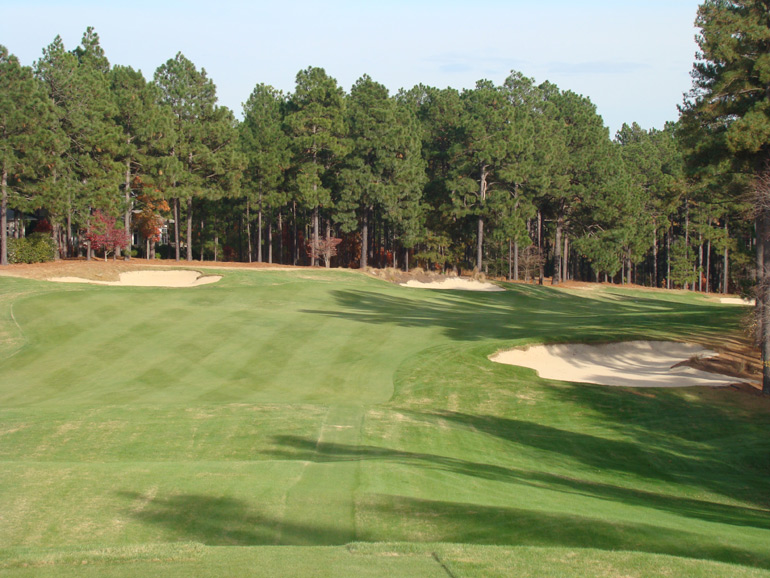
The inside of the dogleg offers the optimal stance and angle into the green. As with several other holes (e.g. the 11th, 13th, and 15th), it is possible to blow a driver through the dogleg if it isn’t shaped appropriately. Unlike the North Course, the driver isn’t an automatic selection on every tee. Finesse plays a distinct role on the South.
Third hole, 485 yards; Uphill par fives can seem like a grind but not this one, thanks to two beautifully placed bunkers in the middle of the fairway 100 yards shy of the green. Options abound each time the golfer confronts the hole. Modest in length, par is amply defended at the green which features the steepest back to front pitch on the course. Power golfers have reached the back of the green in two only to putt off the front in three!
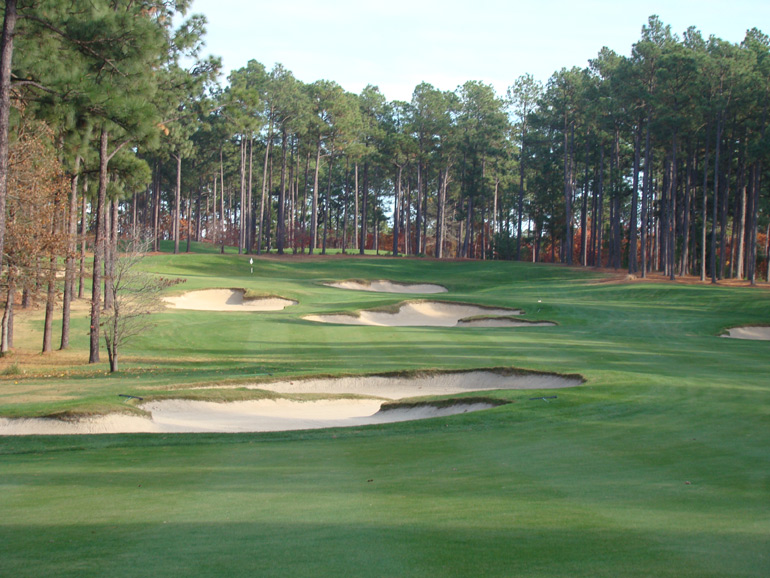
A view from the third tee shows how Fazio utilized the gradual upslope to carve out some of the most graceful bunkers on the entire property.
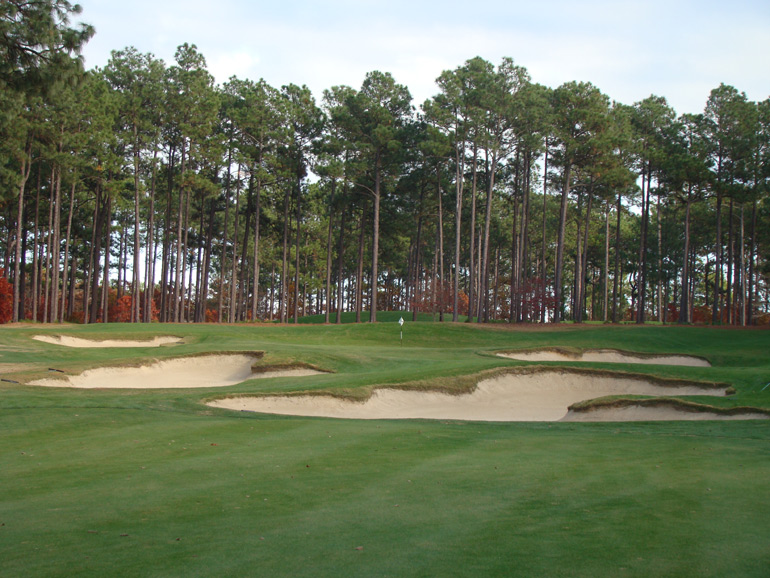
The two central hazards seen above are 100 yards short of the putting surface. When the hole is back right, the golfer dearly loves to get past these bunkers in two so that he can enjoy a pitch down the axis of the green.
Fourth hole, 415 yards; Here is a fine example of bunkers utilized to mis-direct the golfer. The pair of bunkers on the inside of the dogleg plays much bigger than they look as they gather balls in from as much as twenty yards. Often the Tiger who insists on trying to make the 240 yard carry will find his ball stays in the rough and be left with a hanging lie. Better to play away from the bunkers to the middle or even outside of this dogleg right. From here, the golfer has good angle plus a comparatively flat stance. Achieving good contact on the approach shot is crucial as the green tilts away from the player and shunts aside the thin or indifferently struck ball.

This zoomed photograph captures the sloping nature of the ground around the bunker on the inside of the dogleg as well as the front left to back right slope of the green 180 yards in the distance.
Sixth hole, 170 yards; The South’s sister course more often features large, sandy areas which create strategic dilemmas. Though there are several on the South, only on the approach to the fourteenth does one play an integral role. Here, the exposed sand lends the hole visual appeal and might actually distract the golfer from the real task: Getting one’s tee ball to finish below the hole on a green that features a severe tilt to the right.

An uphill putt from twenty-five feet right of this hole location is more desirable than one much closer left but downhill of the hole.
Seventh hole, 540 yards; There is much debate about the tougher course at Forest Creek. The North is longer and features brawnier hazards and more visual intimidation, so the tendency is to select it. Yet, persuasive arguments can be made that the South Course is craftier in the manner in which it bleeds shots away from the golfer. One way it accomplishes this is with a pair of stiff par fives in its middle. Similar to the 560 yard twelfth, the seventh requires smart, stout hitting. A loose first or second shot makes hitting either green in regulation unlikely.

Standing on the tee, a certain appeal exists in seeing the flag at the end of such a long hole. Here’s the plan. One, avoid the 48 yard long bunker off the tee. Two, slot one’s second between the left and right bunkers ahead. Three, avoid getting anywhere near the deep vertical face of bunker that walls off much of the green.
Eighth hole, 335 yards; A real teaser, this gem features a central hazard 230 yards from the Long tees. What to do? Look at the flag and aim for the side of the fairway opposite to the hole location. While the wall of sand created by the six bunkers intimidates, the real kicker is the green that runs from front to back. With forward hole locations, the following scenario plays out with comedic regularity: Aware of all the visible trouble between his drive and the hole, the golfer hits his approach to the middle of the green from where the ball drifts to the back. Unaccustomed to putting uphill toward the front of a green, the first putt comes up well short. Whether he makes the second one or not is immaterial. Heading to the ninth tee, he is left wondering how such a short hole caused such headache.
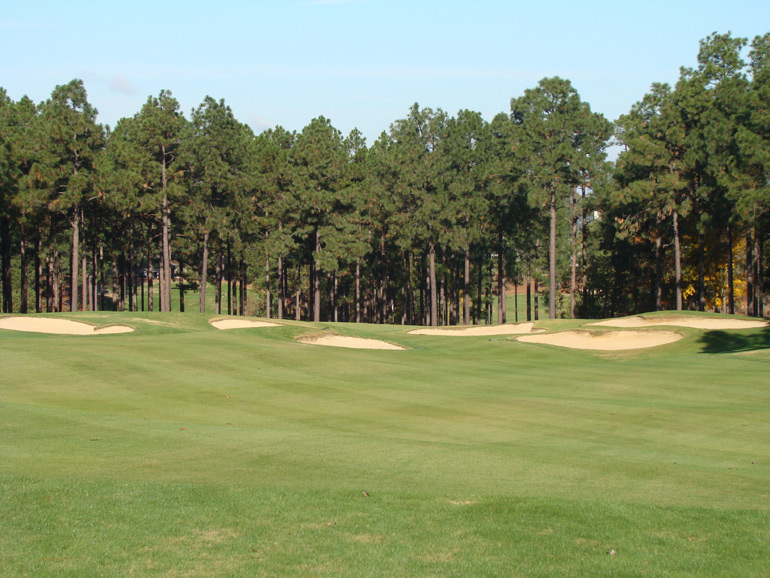
A sea of bunkers is found across the eighth fairway.
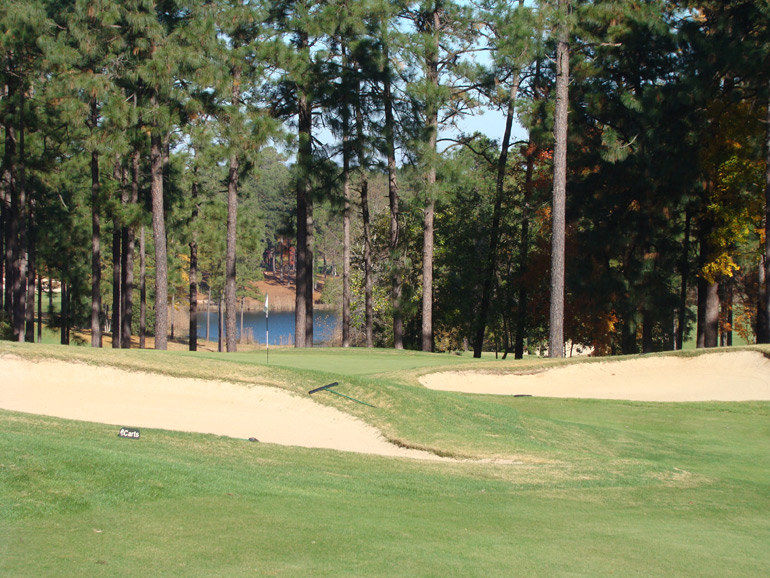
The left side of the fairway is the higher one and affords the golfer a glimpse of the putting surface.
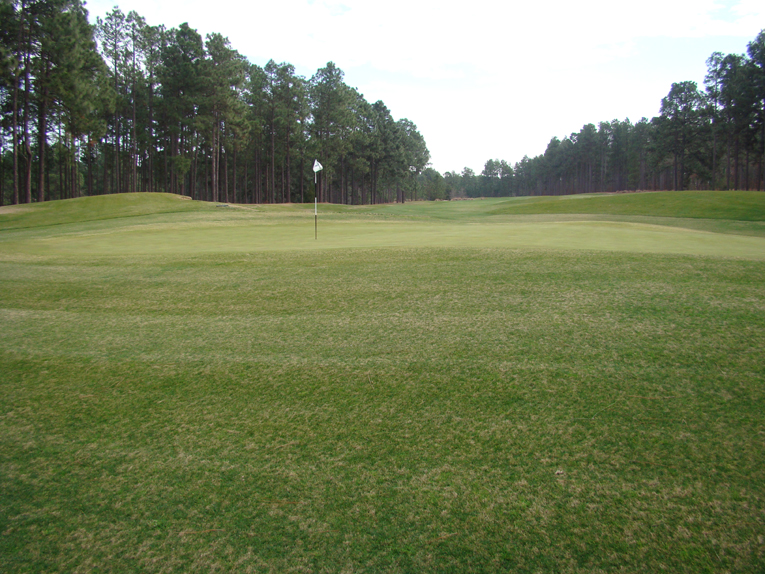
The eighth green is the smallest target on the course at just over 5,000 square feet. As seen from behind, it plays even smaller thanks to its front to back slope and how the left third of the putting surface cants left (i.e. right as seen from behind). This photograph was taken in the dead of winter.
Ninth hole, 430 yards; Fazio puts the screws to the golfer here: The green is fronted by a finger of the spring-fed lake, steeply pitched from back to front, and only 22 paces deep. Even the bail out area on the left makes for an extremely unlikely up and down as the green tilts to the right. Courses built in the mid 1980s regularly featured several holes of such uncompromising difficulty. Golfers grew frustrated watching their golf balls being gobbled up. Tom Fazio was one of the principal architects who led the change away from penal designs to more playable ones. Having said that, every course should have one such brute, and the ninth is that hole on the South.

Finding the fairway off the tee is imperative. The good news is that tee balls pulled left are likely to get a favorable kick into the fairway. Note how the flag is now visible through the pines, courtesy of two large pines wisely being removed a few years ago. One result is that golfers who push their tee ball right have a greater chance of going for the green in two. Such bold recovery shots out of the bermuda rough do lead to heroics but also many more double bogeys.
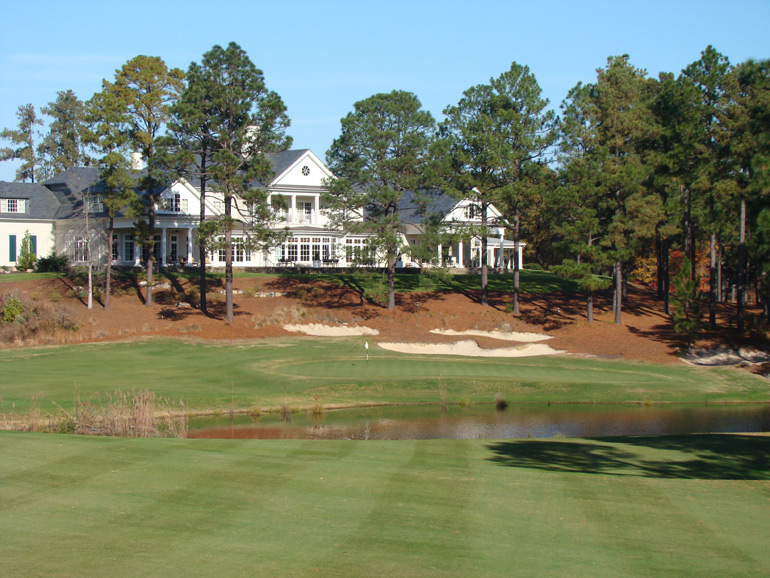
The most stringent shot on the course is the approach to the ninth. Short is obviously no good but the green races away from shots missed long or left as well.
Tenth hole, 225 yards; This dramatic hole generally plays into the prevailing wind. Typical of other green complexes on the South, it features just one greenside bunker and plenty of short grass on the other side. Yet, the ‘safe’ shot steered away from the hazard leaves the golfer a ticklish pitch from a tight lie to a green that tilts away (here from left to right). Depending on one’s proficiency from the sand and the day’s hole location, misses into the hazard might provide the more straightforward recovery.

One thing’s for sure – no one likes starting their day at the tenth hole during crowded club events!
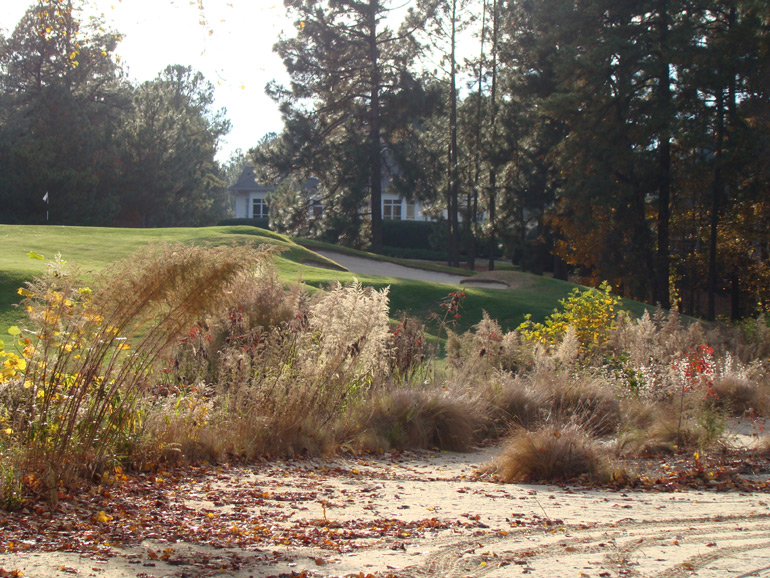
The love grass, big blue stem and dog fennel lend texture but are best appreciated from a distance.
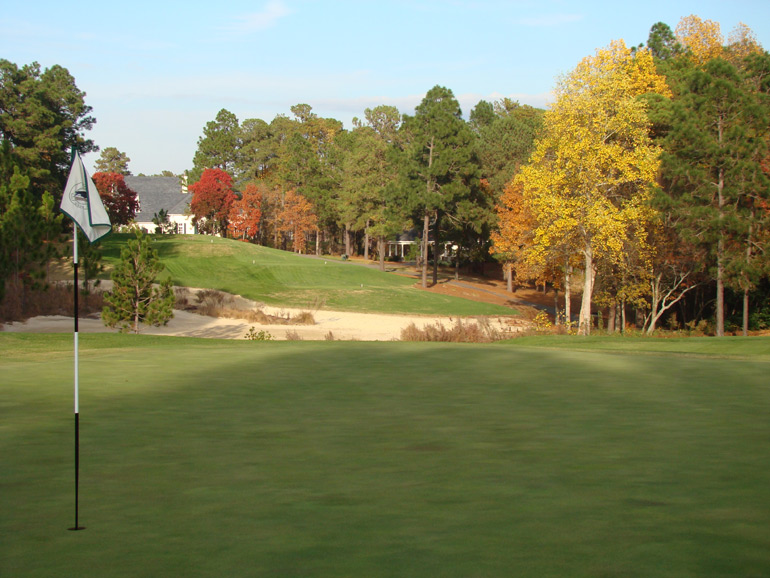
The contrast of the Longleaf pines against the changing leaves on the hardwoods makes autumn an exceptionally fine time to enjoy a game at Forest Creek.
Eleventh hole, 345 yards; Sandwiched in the middle of the course’s toughest five hole stretch, the golfer might look on this modest length hole as a respite – and that would be a mistake! After the eighth, the eleventh is the shortest two shotter on the course but it is so unsympathetic. As a perfect foil to the dogleg right first, this hole turns just as sharply left. Hopes of grandeur crowd into the greedy golfer’s mind but experience has shown that a three wood to the middle of the fairway followed by a short iron to the middle of the green saves the golfer shots over a full playing season.

Fazio tempts the golfer into whipping his drive around the bunkers on the inside of the dogleg. And yet …

… the best case result is a fiddly sixty yard pitch over a deep bunker to a green benched into the hillside. Better to excercise restraint and play one’s three wood somewhere in this area. Maybe your short iron can get close but the hillside which feeds into the putting surface creates many difficult right hole locations.
Thirteenth hole, 405 yards; Fazio has created some of the most photographed courses in modern architecture featuring everything from quarries to deserts to oceans. With expectations come burdens but the strict directive from the Browns and Hall-Jones were to be true to the property. Here we are in the middle of the back nine and Fazio hasn’t created anything glamourous or out of character with the land. So it continues here with an uncompromising dogleg right hole that plays to an uphill green. Real golfers appreciate that window-dressing is unnecessary for quality golf in the Sand Hills of North Carolina.
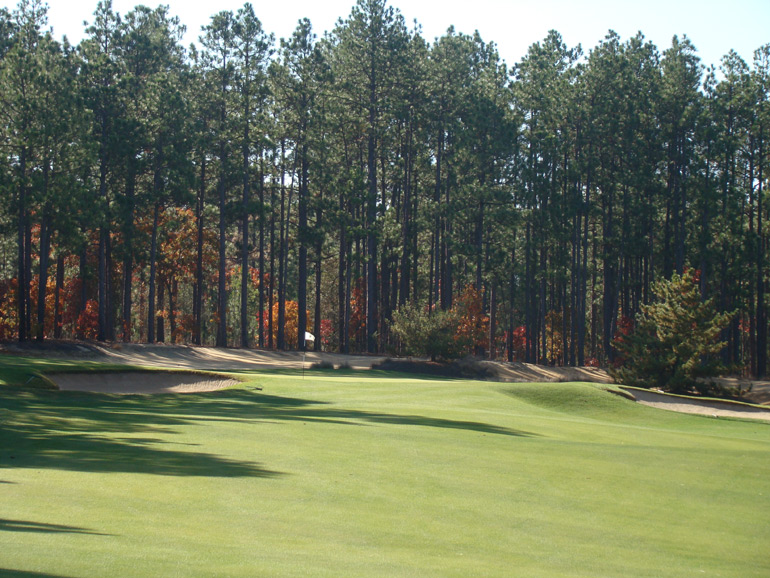
Playing at least one extra club uphill, the thirteenth green presents the classic conundrum of an uphill green that is bunkered left and right. The need to reach the putting surface is offset by the strong desire to avoid being above the hole leaving a ticklish downhiller.
Fourteenth hole, 510 yards; A reachable par five with a green that is open in front for sixty yards may not sound like much but this is one of the best risk/reward holes anywhere. It is such an appealing gambling hole that the question is raised why architects don’t concentrate more often on the area fifty to eighty yards short of par five greens? Often times this area is the least interesting part of a three shotter. Instead, unimaginative architects shove some sort of a water hazard flush against the putting surface. Yet if the area fifty to eighty yards short of the green is full of interest, the hole itself is almost guaranteed to be imbued with options. In this case, the Tiger gets the thrill of trying to flight a three wood approach from a slightly downhill lie over a vast amount of sand to a green open in front. The less accomplished player gains his own sense of achievement by negotiating a lay-up beside the hazard to afford him a pitch to the green. Nothing can be taken for granted as the putting surface drops three feet from back to front.
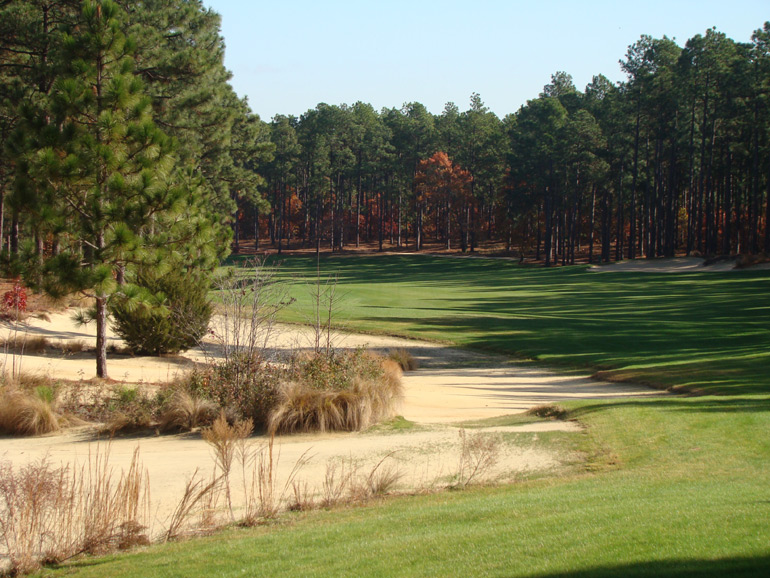
A draw at the far bunker in the shadows is the perfect start.
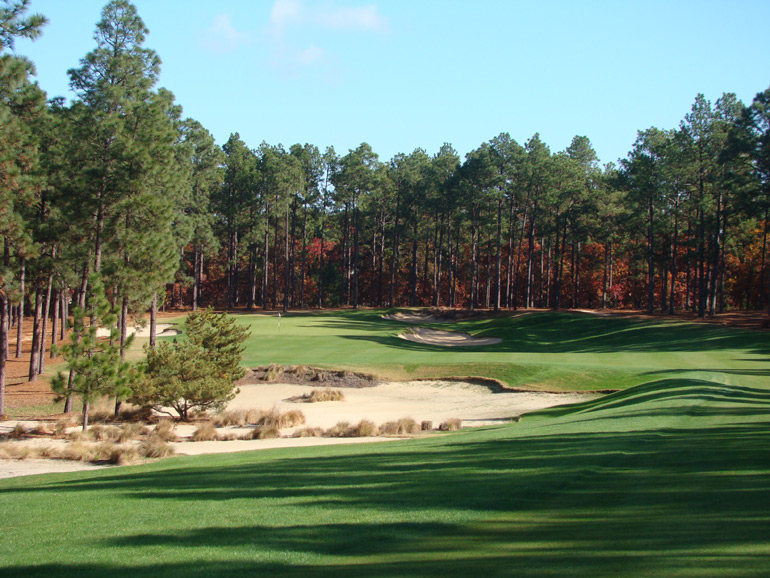
A good drive leaves the golfer in the 230 yard range and a multitude of options exist. Certainly, the most enticing is a crack at the green in two.
Fifteenth hole, 400 yards; Fazio uses the angles well and formulates this hole’s challenge at the green which is high in the middle and low in the front and back. It is better to miss a back hole location long as at least that way, the golfer has a straightforward uphill chip shot. If one comes up short of the middle hump with his approach for a back hole location, the matter becomes daunting. The putt must be coaxed over the brow and down the slope. If the strike is too gentle, he leaves a quick downhill ten footer for a two putt … and then … a six footer for a three putt … now he’s stomping to the sixteenth tee after four putting. Don’t ask how the author knows THIS!
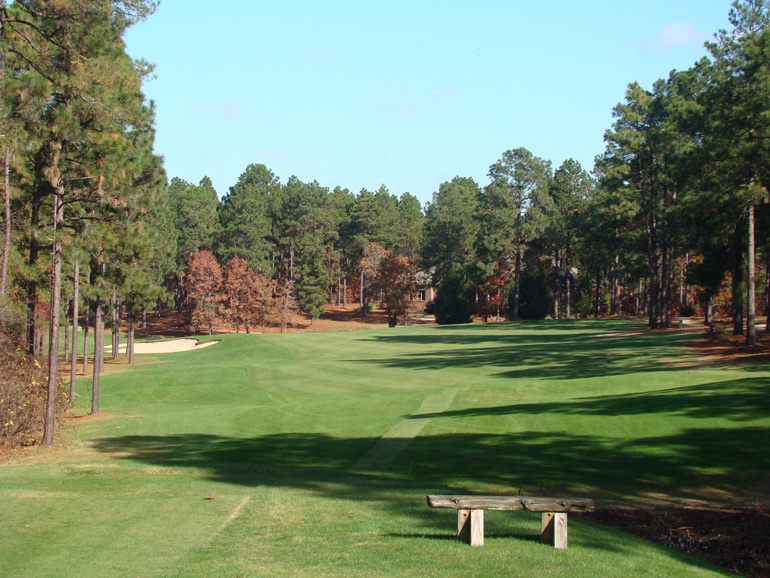
A solitary bunker was all that was required on the inside of this dogleg left. Note how its sand as well as the sand by the green is keep below the playing surfaces. Such low profile features ensure that the architecture is neither fussy nor busy and that an air of tranquility prevails.
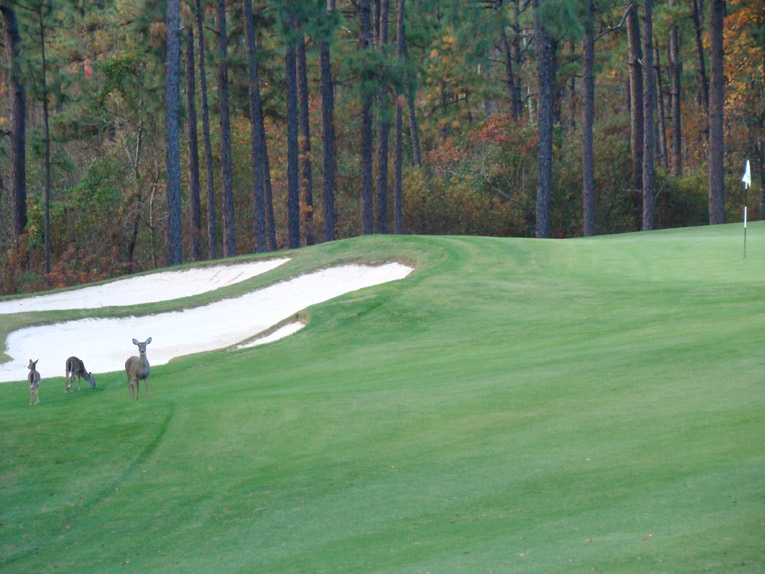
Certainly these deer in front of the fifteenth greenside bunker seem to think so! Note how the putting surface is high in the middle and slopes forward in the front and away at the rear.
Sixteenth hole, 420 yards; A fairway bunker is perfectly placed to lend strategy to a straight hole. The closer the golfer hugs the bunker on the right, the better his approach angle into the green. If he shuns the bunker and veers left, he will have to carry the six foot deep bunker that guards the green’s left side and he may be partially blocked by a strand of tall pines. Driving to the clubhouse, the player passes this handsome hole. In many ways, it demonstrates what he can expect during his round: A broad playing corridor between pines, rolling land with the tee ball and approach played over valleys, and large scale features.

The best play from the sixteenth tee is toward the right center of the fairway near the bunker in the shadows. From there …
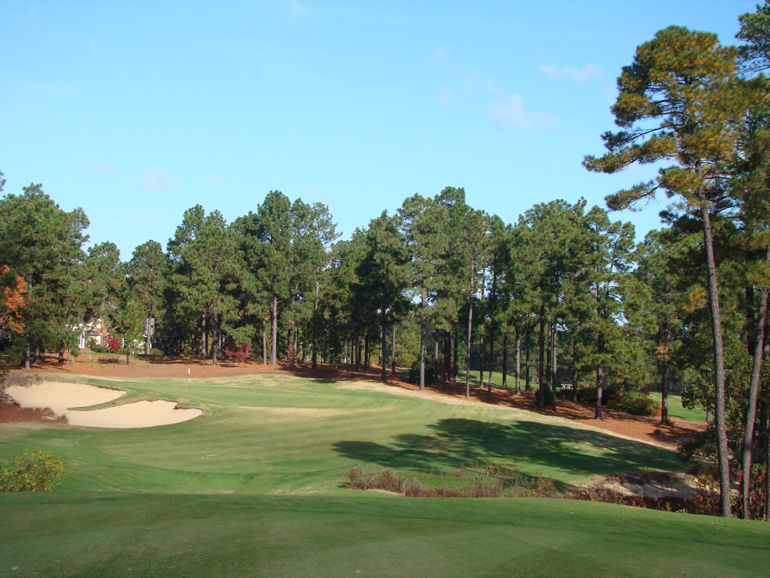
… the golfer enjoys a level stance and a fine look down the axis of the angled green. Note the appealing scale of the greenside bunker.
Seventeenth hole, 170 yards; The one shot holes on the South Course require a forced carry either over wetlands (the second), scrub (the sixth and tenth) or a formalized water hazard here. Very picturesque, this hole features the greatest drop in elevation of any single shot on the course. As such it is hard to judge, especially as it is the first shot that the golfer plays in a westerly direction on this nine. Add up all the elements – elevated tee exposed to the wind, drop in elevation, change in direction, steepest greenside bunker face on the course, a shallow putting surface tilted to the right- and you have a penultimate hole that commands the respect of every skill level.

Played downhill into its own attractive natural amphitheater, the seventeenth provides the stage for a shot to remember. The green is the only putting surface on the course that measures over 7,000 square feet.
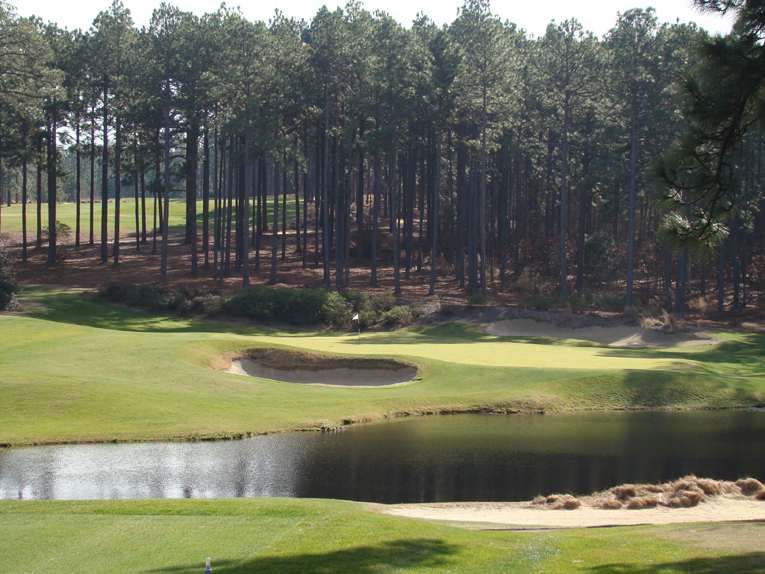
This photograph was taken three months later than the one above with Forest Creek now showing its winter colors. Golfers from as far away as Toronto have long made the drive to the Pinehurst area during winter months to enjoy the firm playing conditions that the sandy soil base provides.
Eighteenth hole, 410 yards; Initially, the Fazio team contemplated concluding with a par five with one’s third shot over water to a green at the base of the clubhouse. Fazio personally vetoed the idea, determining that there were too many sequelae without a recovery from water whereby the golfer would finish on a demoralizing note. So they pulled the green forward and the twelve acre lake now serves primarily as a backdrop. Interestingly, member Jim Lewis once asked the long time, beloved professional Waddy Stokes what he considered the most difficult hole on the course for the ace player to birdie. Unhesitatingly, he answered the eighteenth. Why? The ample fairway provides relatively clean sailing but Waddy’s selection was based on the green contours. The front third slopes toward the golfer and offers few hole locations while the last two thirds slopes away. Waddy contended that the fallaway slope created more worries in the head of a good player than any other challenge.

The long view from the tee of the flag silhouetted against the lake makes for a memorable finishing hole. At 40 yards in width, the eighteenth fairway is an ample target.
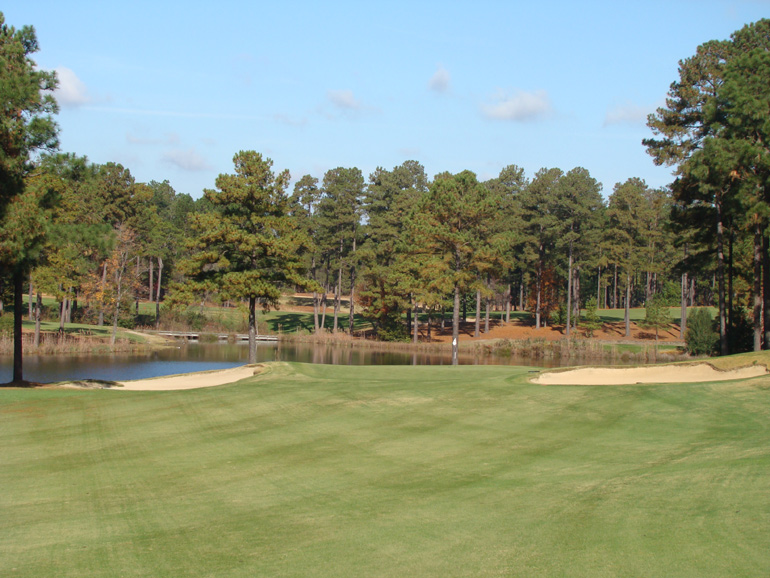
After a well placed drive here, all seems fine. Yet, the ball is likely to be slightly above one’s stance and there is more to the green than meets the eye.
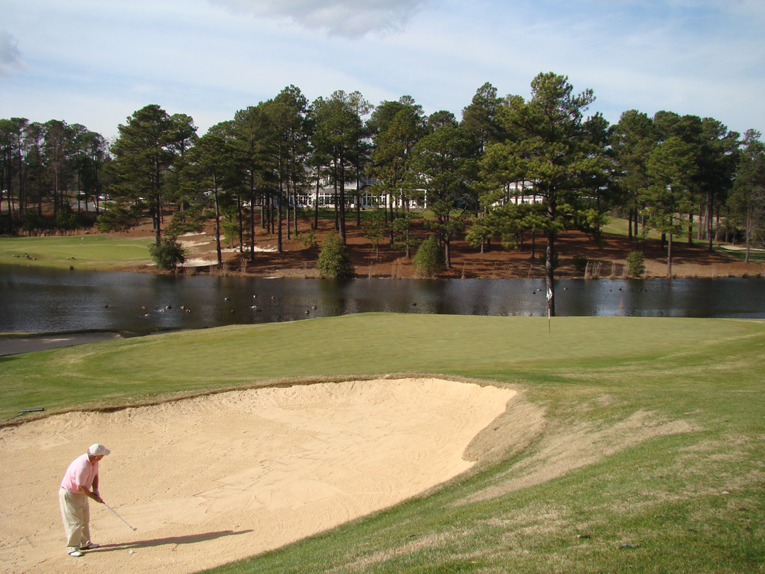
Closer inspection of the green reveals that its first third faces the approaching golfer before cresting and running away toward the water. Good players hate not feeling in control of their ball and the fallaway slope is such an agent of fear.
One side benefit of pulling the Home green forward was that it left an untilized area between it and the clubhouse. Brown approached Fazio with the concept of a nineteenth hole. This was in 1997 before such holes had gained popularity. Fazio embraced the idea and the ensuing 165 yard one shot remains the best 19th hole that the author has seen.
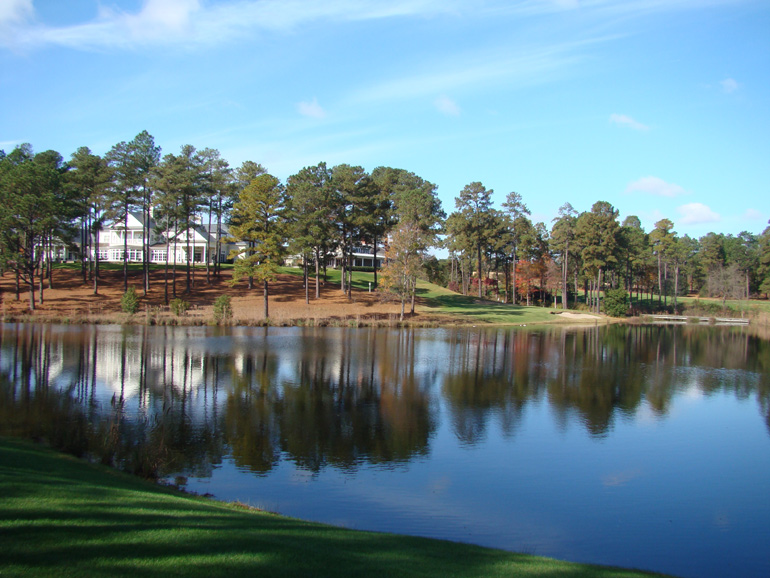
From off the back of the eighteenth green, the golfer is given one more chance to improve his standing against his opponent. Good luck!
Not unlike the famous Ross course in the village, Fazio gives the golfer plenty of room off the tee and presents the heart of the challenge within 40 yards of the green. For some of the strategic dilemmas to come off properly (i.e. in order to carry the fairway bunker at the third, to fret about the fallaway slopes at the eighth, fifteenth and eighteenth greens, etc.), fast and firm playing conditions must exist. Green Keeper Bill Patton has the advantage of a sandy base and limited play but still his work is to be commended. The two courses at Forest Creek are consistently the firmest courses in town.
Where there is good hunting there is often good golf. Both pursuits benefit from temperate climates, rolling land skirting past wetlands, and broad fertile spaces. For the same reasons that Terry Brown’s grandfather loved it as a hunter, Terry loves it as a golfer. No doubt Charles Meyer would be pleased that people are enjoying the beauty and dimensions of the property that he pieced together many years ago. Fazio’s restrained design amplifies its low key, serene nature. Unlike so many modern courses that followed in the Pinehurst area after Ross’s death, water hazards and built-up features are at a minimum. Fazio, it appears borrowed a page from Donald Ross’s playbook and allowed a well routed course with interesting green complexes to do the talking. Such a simple, uncluttered philosophy worked well back in Ross’s day of the Golden Age of golf course architecture and it works as wonderfully today at the South Course at Forest Creek.
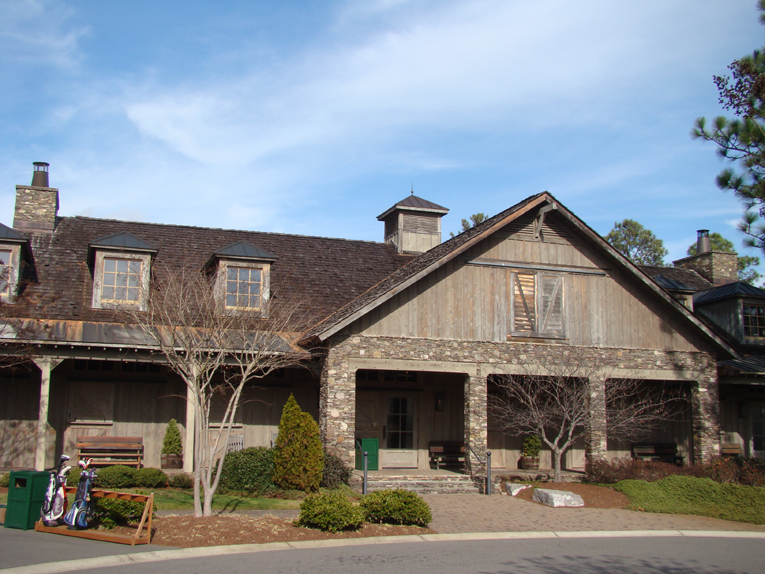
The rustic qualities of the men’s locker room pay tribute to the farm and hunting origins of the property.
The End

